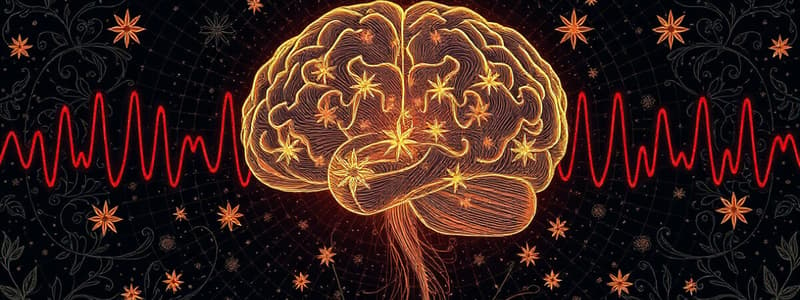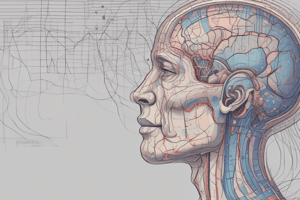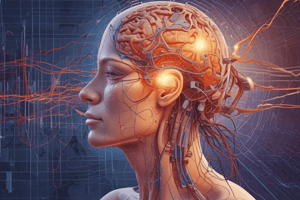Podcast
Questions and Answers
Consciousness is best described as:
Consciousness is best described as:
- The sole determinant of all human behavior.
- Primarily influenced by external stimuli, overriding internal processes.
- A product of dynamic interactions within distributed neural networks. (correct)
- A function of a single, distinct brain structure.
An EEG directly measures neuronal firing rates within the brain.
An EEG directly measures neuronal firing rates within the brain.
False (B)
Explain how an EEG output allows researchers to infer different states of consciousness.
Explain how an EEG output allows researchers to infer different states of consciousness.
EEG output, comprising amplitude and frequency of brain waves, correlates with different states of consciousness. For example, fast, high-frequency beta waves are associated with active thinking, while slow, low-frequency delta waves dominate deep sleep. Analyzing these patterns helps identify states like alertness, relaxation, and sleep stages.
_________ waves, characterized by their fast frequency, are associated with active thinking and problem-solving.
_________ waves, characterized by their fast frequency, are associated with active thinking and problem-solving.
Match the brainwave patterns with their corresponding states of consciousness:
Match the brainwave patterns with their corresponding states of consciousness:
Which statement accurately describes the relationship between brainwaves and states of consciousness?
Which statement accurately describes the relationship between brainwaves and states of consciousness?
Biological rhythms are exclusively circadian rhythms.
Biological rhythms are exclusively circadian rhythms.
Explain how circadian rhythms are a specific type of biological rhythm and provide an example.
Explain how circadian rhythms are a specific type of biological rhythm and provide an example.
The suprachiasmatic nucleus (SCN) in the brain is crucial for regulating circadian rhythms and is sensitive to ________.
The suprachiasmatic nucleus (SCN) in the brain is crucial for regulating circadian rhythms and is sensitive to ________.
Ignoring circadian rhythms, such as working night shifts, can lead to:
Ignoring circadian rhythms, such as working night shifts, can lead to:
An electromyograph (EMG) is used to measure brainwave activity during sleep studies.
An electromyograph (EMG) is used to measure brainwave activity during sleep studies.
What is the role of an electrooculograph (EOG) in sleep studies?
What is the role of an electrooculograph (EOG) in sleep studies?
________ jerks are muscle contractions that may occur during the transition to Stage 1 sleep.
________ jerks are muscle contractions that may occur during the transition to Stage 1 sleep.
Slow-wave sleep is characteristic of which stages of sleep?
Slow-wave sleep is characteristic of which stages of sleep?
Dreaming only occurs during REM sleep.
Dreaming only occurs during REM sleep.
Describe the paradoxical nature of REM sleep.
Describe the paradoxical nature of REM sleep.
During REM sleep, muscle _________ prevents us from acting out our dreams.
During REM sleep, muscle _________ prevents us from acting out our dreams.
Night terrors are most likely to occur during:
Night terrors are most likely to occur during:
The duration of REM sleep periods decreases as the night progresses.
The duration of REM sleep periods decreases as the night progresses.
How does the sleep cycle evolve throughout a typical night?
How does the sleep cycle evolve throughout a typical night?
The ________, located in the brainstem, is crucial for the initiation of REM sleep.
The ________, located in the brainstem, is crucial for the initiation of REM sleep.
Severing nerve fibers in the pons, as observed in animal studies, primarily disrupts:
Severing nerve fibers in the pons, as observed in animal studies, primarily disrupts:
The energy conservation theory of sleep suggests that sleep primarily restores bodily resources.
The energy conservation theory of sleep suggests that sleep primarily restores bodily resources.
Describe the predation protection theory of sleep.
Describe the predation protection theory of sleep.
Sleep deprivation primarily leads to deficits in _________ function, mood disturbances, and increased accident risk.
Sleep deprivation primarily leads to deficits in _________ function, mood disturbances, and increased accident risk.
Selective REM sleep deprivation, when followed by normal sleep, typically results in:
Selective REM sleep deprivation, when followed by normal sleep, typically results in:
Selective slow-wave sleep deprivation primarily impacts procedural memory consolidation.
Selective slow-wave sleep deprivation primarily impacts procedural memory consolidation.
What is memory consolidation, and how do REM and slow-wave sleep contribute to it?
What is memory consolidation, and how do REM and slow-wave sleep contribute to it?
_________ is a sleep disorder characterized by difficulty falling or staying asleep.
_________ is a sleep disorder characterized by difficulty falling or staying asleep.
Narcolepsy is often associated with the immediate onset of which sleep stage?
Narcolepsy is often associated with the immediate onset of which sleep stage?
Sleep apnea only affects REM sleep.
Sleep apnea only affects REM sleep.
In which sleep stage does somnambulism (sleepwalking) typically occur?
In which sleep stage does somnambulism (sleepwalking) typically occur?
REM sleep behavior disorder involves acting out _________ due to a lack of muscle atonia during REM sleep.
REM sleep behavior disorder involves acting out _________ due to a lack of muscle atonia during REM sleep.
Nightmares primarily occur during which sleep stage?
Nightmares primarily occur during which sleep stage?
State theory of hypnosis suggests that hypnosis is merely role-playing.
State theory of hypnosis suggests that hypnosis is merely role-playing.
Contrast state and non-state theories of hypnosis.
Contrast state and non-state theories of hypnosis.
_________ is a mental practice involving focused attention to achieve a heightened state of awareness and emotional calm.
_________ is a mental practice involving focused attention to achieve a heightened state of awareness and emotional calm.
Physiological changes associated with meditation include:
Physiological changes associated with meditation include:
Meditation is simply a form of relaxation and provides no additional benefits.
Meditation is simply a form of relaxation and provides no additional benefits.
Define psychoactive drugs and categorize them based on their effects.
Define psychoactive drugs and categorize them based on their effects.
_________ are psychoactive drugs that increase alertness, energy, and attention.
_________ are psychoactive drugs that increase alertness, energy, and attention.
Which category of psychoactive drugs primarily induces altered perceptions and sensory experiences?
Which category of psychoactive drugs primarily induces altered perceptions and sensory experiences?
Drug tolerance means increased sensitivity to a drug after repeated use.
Drug tolerance means increased sensitivity to a drug after repeated use.
Explain how amphetamines and cocaine affect dopamine neurotransmission differently.
Explain how amphetamines and cocaine affect dopamine neurotransmission differently.
The _________ dopamine pathway in the brain is believed to be central to the reinforcing effects of abused drugs.
The _________ dopamine pathway in the brain is believed to be central to the reinforcing effects of abused drugs.
Physical dependence on a drug is characterized by:
Physical dependence on a drug is characterized by:
Psychological dependence always involves severe physical withdrawal symptoms.
Psychological dependence always involves severe physical withdrawal symptoms.
Compare and contrast physical and psychological dependence.
Compare and contrast physical and psychological dependence.
According to the provided text, ________ is identified as having the most diverse adverse health effects among psychoactive drugs.
According to the provided text, ________ is identified as having the most diverse adverse health effects among psychoactive drugs.
Viewing alcohol-abuse disorder as a moral choice emphasizes:
Viewing alcohol-abuse disorder as a moral choice emphasizes:
Which statement best describes the relationship between consciousness and behavior?
Which statement best describes the relationship between consciousness and behavior?
Match the following brainwave patterns with their corresponding states of consciousness:
Match the following brainwave patterns with their corresponding states of consciousness:
Ignoring circadian rhythms, such as consistently working night shifts, has no significant long-term effects on an individual's physical and mental well-being.
Ignoring circadian rhythms, such as consistently working night shifts, has no significant long-term effects on an individual's physical and mental well-being.
REM sleep is paradoxical because while it is considered a deep sleep stage characterized by muscle atonia and difficulty in awakening, brainwave activity during REM sleep is similar to that observed during __________, specifically dominated by __________ waves.
REM sleep is paradoxical because while it is considered a deep sleep stage characterized by muscle atonia and difficulty in awakening, brainwave activity during REM sleep is similar to that observed during __________, specifically dominated by __________ waves.
Briefly describe two evolutionary theories that attempt to explain the purpose of sleep in humans and animals.
Briefly describe two evolutionary theories that attempt to explain the purpose of sleep in humans and animals.
Flashcards
Consciousness
Consciousness
Being aware and able to think and perceive one's surroundings, thoughts, and emotions.
EEG (Electroencephalogram)
EEG (Electroencephalogram)
A neuroimaging technique that records the brain's electrical activity via scalp electrodes.
How EEG Works
How EEG Works
Detects electrical signals from neurons, translated into graphical brain waves.
Beta Waves
Beta Waves
Signup and view all the flashcards
Alpha Waves
Alpha Waves
Signup and view all the flashcards
Theta Waves
Theta Waves
Signup and view all the flashcards
Delta Waves
Delta Waves
Signup and view all the flashcards
Biological Rhythms
Biological Rhythms
Signup and view all the flashcards
Circadian Rhythms
Circadian Rhythms
Signup and view all the flashcards
Light's Role in Circadian Rhythm
Light's Role in Circadian Rhythm
Signup and view all the flashcards
Electromyograph (EMG)
Electromyograph (EMG)
Signup and view all the flashcards
Electrooculograph (EOG)
Electrooculograph (EOG)
Signup and view all the flashcards
NREM Stage 1
NREM Stage 1
Signup and view all the flashcards
NREM Stage 2
NREM Stage 2
Signup and view all the flashcards
NREM Stages 3 and 4
NREM Stages 3 and 4
Signup and view all the flashcards
REM Sleep
REM Sleep
Signup and view all the flashcards
Brainstem Sleep Structure
Brainstem Sleep Structure
Signup and view all the flashcards
Evolutionary Sleep Theories
Evolutionary Sleep Theories
Signup and view all the flashcards
Effects of Sleep Deprivation
Effects of Sleep Deprivation
Signup and view all the flashcards
Selective Sleep Deprivation
Selective Sleep Deprivation
Signup and view all the flashcards
Insomnia
Insomnia
Signup and view all the flashcards
Narcolepsy
Narcolepsy
Signup and view all the flashcards
Sleep Apnea
Sleep Apnea
Signup and view all the flashcards
Night Terrors
Night Terrors
Signup and view all the flashcards
Theories of Hypnosis
Theories of Hypnosis
Signup and view all the flashcards
Meditation
Meditation
Signup and view all the flashcards
Depressants
Depressants
Signup and view all the flashcards
Hallucinogens
Hallucinogens
Signup and view all the flashcards
Stimulants
Stimulants
Signup and view all the flashcards
Opioids
Opioids
Signup and view all the flashcards
Psychoactive Drugs
Psychoactive Drugs
Signup and view all the flashcards
Addiction Pathway
Addiction Pathway
Signup and view all the flashcards
Narcotics' Effects
Narcotics' Effects
Signup and view all the flashcards
Stimulants' Effects
Stimulants' Effects
Signup and view all the flashcards
Cannabis' Effects
Cannabis' Effects
Signup and view all the flashcards
Drug Tolerance
Drug Tolerance
Signup and view all the flashcards
Dopamine's Effects
Dopamine's Effects
Signup and view all the flashcards
Dopamine's Role in Dependence
Dopamine's Role in Dependence
Signup and view all the flashcards
Physical Dependence
Physical Dependence
Signup and view all the flashcards
Psychological Dependence
Psychological Dependence
Signup and view all the flashcards
Drug with Most health Effects
Drug with Most health Effects
Signup and view all the flashcards
Views on Alcohol Abuse
Views on Alcohol Abuse
Signup and view all the flashcards
How Amphetamines work in the synapse
How Amphetamines work in the synapse
Signup and view all the flashcards
How Cocaine works in the synapse
How Cocaine works in the synapse
Signup and view all the flashcards
Ignoring Circadian Rhythms
Ignoring Circadian Rhythms
Signup and view all the flashcards
Study Notes
Consciousness Defined
- Consciousness involves awareness of surroundings, thoughts, and emotions
- Consciousness arises from activity within distributed neural networks
- Not all behavior is determined by conscious thought
Electroencephalogram (EEG)
- EEG is a neuroimaging technique that records the brain's electrical activity
- Electrodes placed on the scalp capture brain waves or electrical impulses
- EEG monitors overall brain function and states of consciousness
EEG Function and Output
- EEG detects electrical signals from neurons on the cortical surface
- Signals are translated into graphical representations called brain waves
- The output shows amplitude and frequency of waves
- Researchers identify brain activity patterns correlated with states of consciousness
- Beta waves correlate with active thinking
- Delta waves dominate during deep sleep
- The brain remains continuously active, even without conscious engagement
States of Consciousness and Brainwave Activity
- Beta waves indicate active thinking, problem-solving, and alertness
- Alpha waves signify relaxed awareness and calmness, often occurring during the transition into sleep (Stage 1)
- Theta waves are associated with light sleep or deep relaxation, common in Stage 1 and parts of Stage 2 sleep
- Delta waves dominate in deep, dreamless sleep during Stages 3 and 4
Biological Rhythms
- Biological rhythms are periodic fluctuations in physiological functioning in living organisms
- These fluctuations include sleep-wake cycles, hormone secretion, and body temperature
- Animals exhibit changes in behavior and physiological states in response to these rhythms
Circadian Rhythms
- Circadian rhythms are biological rhythms with a cycle of approximately 24 hours
- Sleep-wake cycle exemplifies a circadian rhythm
- These rhythms synchronize daily physiological processes with the external environment
- Crucial for the day-night cycle
- All circadian rhythms are biological, but not all biological rhythms are circadian
Consequences of Ignoring Circadian Rhythms
- Ignoring circadian rhythms disrupts the body's internal clock
- Light detected by the retina signals the suprachiasmatic nucleus (SCN)
- The SCN inhibits melatonin secretion by the pineal gland
- Melatonin promotes sleep
- Decreased light weakens the inhibitory signal, allowing melatonin secretion
- Ignoring circadian rhythms leads to misalignment.
- Misalignment causes poor sleep quality manifested as fatigue and irritability, health complications like cardiovascular issues, cognitive impairment, and mood disorders
- The natural circadian rhythm impacts both physical and mental health
Studying Sleep: Electromyograph (EMG)
- Sleep is studied by recording physiological measures
- EMG measures muscle activity via electrical signals
- EMGs on facial and leg muscles differentiate sleep stages, such as REM sleep
Studying Sleep: Electrooculograph (EOG)
- EOG records electrical activity of the eyes
- Electrodes around the eyes track rapid eye movements (REM)
- Rapid eye movements are crucial for identifying stages of sleep
The Sleep Cycle
- The sleep cycle progresses through Stages 1 and 2
- Progresses to Stages 3 and 4 in slow-wave sleep
- The cycle reverses back through Stages 3 and 2 before REM
Stages of Sleep
- Light sleep characterizes Stages 1 and 2 of NREM sleep
- Deep sleep, also called slow-wave sleep, categorizes stages 3 and 4 of NREM sleep
- REM sleep is a distinct stage, different from NREM
- Stage 1 lasts 5-10 minutes
- Stage 2 lasts 20 minutes
- Stages 3 and 4 each last 30 minutes
- REM sleep lasts 10 minutes
- Physiological changes occur in each stage
Brainwaves and Sleep Stages
- Theta waves are linked to Stage 1 sleep
- Sleep spindles are linked to Stage 2 sleep
- Delta waves are linked to Stages 3 and 4 sleep
- Beta waves are linked to REM sleep
Behaviours Associated with Sleep
- Hypnic jerks mark Stage 1 sleep
- Slow body movements occur during Stages 3 and 4 sleep
- Rapid eye movements and paralysis characterize REM sleep
Rapid Eye Movement (REM) Sleep
- Rapid Eye Movement (REM) sleep features deep sleep qualities
- There is difficulty awakening during Rapid Eye Movement (REM) sleep
- Rapid Eye Movement (REM) sleep also features awake-like brainwave activity
- Rapid Eye Movement (REM) sleep enables vivid dreaming
- Rapid Eye Movement (REM) sleep also minimizes external disturbances
- Awakening from Rapid Eye Movement (REM) sleep allows participants to vividly recall dreams
Dreaming
- Dreaming occurs in both Rapid Eye Movement (REM) and non-Rapid Eye Movement (REM) sleep
- Dreams differ significantly in quality and frequency
- Rapid Eye Movement (REM) dreams are more frequent and vivid
- Non-Rapid Eye Movement (REM) dreams often involve fragmented or anxiety-provoking imagery
- Night terrors typically occur during deep non-Rapid Eye Movement (REM) sleep
Sleep Cycles
- Four sleep cycles consist of a nights sleep
- Each cycle is about 90 minutes
- The first Rapid Eye Movement (REM) period is short but lengthens later
- Non-Rapid Eye Movement (REM) sleep becomes shorter and shallower later
Sleep Requirements Across Life
- Sleep requirements vary from infancy to late adulthood
- Infants need 16-18 hours of sleep
- Rapid Eye Movement (REM) sleep comprises 50%
- Adulthood requires 7-9 hours of sleep
- Late adulthood experiences stable sleep with declining quality and frequent awakenings
Brainstem's Role in Sleep
- The pons is involved in sleep regulation
- The pons facilitates REM initiation
- Severing nerve fibers leads to continuous sleep states and affects sleep quality
Evolutionary Theories on Sleep
- Energy Conservation suggests that sleep reduces energy consumption by 30%
- Predation Protection reduces exposure by sleeping during vulnerable hours
- Restoration of Bodily Resources facilitates physical and cognitive restoration, promoting overall health
Effects of Sleep Deprivation
- Sleep deprivation leads to cognitive impairments, mood disturbances, and reduced overall performance
- There are difficulties with attention, reasoning, problem-solving and memory recall
- It causes increases in irritability and anxiety
- There is a lack of self-awareness that can increase chances of accidents
Selective Sleep Deprivation
- It involves depriving participants of these stage of sleep
- It's for studying impacts on cognitive function and overall health
Effects of REM sleep deprivation
- REM sleep deprivation increases irritability
- REM sleep deprivation causes difficulty concentrating and impairs memory functions
- REM rebound occurs with later sleep
Effects of Slow Wave Sleep Deprivation
- Slow wave sleep deprivation can cause impairments in memory consolidation
- Slow wave sleep deprivation may lead to increased feelings of fatigue
Role of REM and Slow Wave Sleep
- REM sleep involved in emotional an procedural memories
- Slow wave sleep is essential for consolidating declarative memories
Insomnia
- Trouble falling asleep or staying asleep
- Occurs during any stage of sleep
- It may lead to daytime impairments
Narcolepsy and Sleep Apnea
- Narcolepsy features excessive daytime sleepiness
- The subject may have sudden attacks of Rapid Eye Movement (REM) sleep
- It may cause disrupted sleep patterns
- Sleep apnea involves interruptions in breathing in all sleep stages
Parasomnias
- Night terrors occur in slow wave sleep, these involve episodes of fear or panic
- Somnambulism occurs in slow wave sleep
- The subject may perform complex behaviors
- Rapid Eye Movement (REM) sleep Behavior Disorder and Nightmares
- Rapid Eye Movement (REM) Sleep Behavior Disorder acting out of dreams due to a lack of muscle atonia during, and potentially harmful behavior
- Nightmares are in Rapid Eye Movement (REM) sleep that can lead to fear, anxiety and clear recall
Hypnosis
- Hypnosis exists as a distinct altered state of consciousness in the State Theory
- Alterations in perception and heightened suggestibility may occur
- Social and cognitive factors may impact hypnosis in Non-State Theory
Theories of Hypnosis
- Altered brain activity may cause experiences like hallucinations or pain suppressions
- Hypnosis relies on expectations and compliance
Meditation's Physiological Benefits
- Meditation helps achieve heightened awareness, emotional calm, and mental clarity
- Reductions in heart rate promote cardiovascular health
- There may be a lowering of stress hormones reduces stress and anxiety
- An increase in brain activity may occur and contributes to improved mental processes
Meditation vs Relaxation
- Meditation encourages mental engagement and self-reflection
- This may have benefits such as improved focus, emotional resilience, and psychological health
- It's more than a temporary escape
Psychoactive Drugs
- Psychoactive drugs significantly alter brain function, mood, consciousness, cognition, and behavior
- Stimulants such as amphetamines increase alertness
- Depressants, such as alcohol, reduce anxiety
- Hallucinogens, such as LSD, induce altered perceptions
- Opioids, such as morphine, provide pain relief
- These drug carry risks of medicinal properties like adding dependence issues
Alcohol Consumption
- Cannabis accounts for a percentage the population
- The youth may uses the dug from an early age
- Illicit drug like cocaine include other issue
Tolerance for substances
- Narcotics can lead to feelings of euphoria
- Other drugs may include anxiety or more issues
Side effects of drugs like MDMA
- The drug may lead to perceptual distortion
- There may also heart distresst or dependence issues
- Withdrawal Symptoms occur when Drug use Ceases
- There are numerous drugs with varied effects of those
Drug Tolerance Defined
- Drug tolerance is a diminished response after repeated use
- There is need for increased doses and higher risks
Neurotransmitter Effects of Drugs of Abuse
- Manipulation occurs especially with Dopamine (DA) and norepinephrine (NE)
- Amphetamines enhance the dopamine neurotransmitters to create greater increase in synaptic activity
- Cocaine accumulation reinforces pleasurable effects and side effects
Brain Pathways involved in reinforcing the effects of drug
Addictiveness
- Interactions occur for abused brain
- This process is driven by dopamine
Effects of Dopamine
- Dopamine impacts mood, reward behavior, and feelings of pleasure
Dependence and Withdraw
- Physical Dependence has symptoms of Nausea, Mood issues and Tremor
- Psychological withdrawal manifests mental cravings
Alcohol Use Disorder
- The effects and choices for persons as a point in the text are varied
- Alcohol is a chronic issue
- One may have other personal choices and interventions
Studying That Suits You
Use AI to generate personalized quizzes and flashcards to suit your learning preferences.





